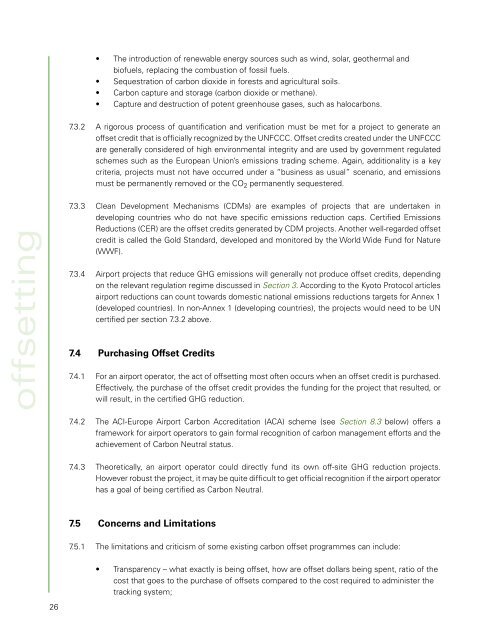Airport Greenhouse Gas Emissions Management - Zurich Airport
Airport Greenhouse Gas Emissions Management - Zurich Airport
Airport Greenhouse Gas Emissions Management - Zurich Airport
You also want an ePaper? Increase the reach of your titles
YUMPU automatically turns print PDFs into web optimized ePapers that Google loves.
• The introduction of renewable energy sources such as wind, solar, geothermal and<br />
biofuels, replacing the combustion of fossil fuels.<br />
• Sequestration of carbon dioxide in forests and agricultural soils.<br />
• Carbon capture and storage (carbon dioxide or methane).<br />
• Capture and destruction of potent greenhouse gases, such as halocarbons.<br />
7.3.2 A rigorous process of quantification and verification must be met for a project to generate an<br />
offset credit that is officially recognized by the UNFCCC. Offset credits created under the UNFCCC<br />
are generally considered of high environmental integrity and are used by government regulated<br />
schemes such as the European Union’s emissions trading scheme. Again, additionality is a key<br />
criteria, projects must not have occurred under a “business as usual” scenario, and emissions<br />
must be permanently removed or the CO 2 permanently sequestered.<br />
offsetting<br />
7.3.3 Clean Development Mechanisms (CDMs) are examples of projects that are undertaken in<br />
developing countries who do not have specific emissions reduction caps. Certified <strong>Emissions</strong><br />
Reductions (CER) are the offset credits generated by CDM projects. Another well-regarded offset<br />
credit is called the Gold Standard, developed and monitored by the World Wide Fund for Nature<br />
(WWF).<br />
7.3.4 <strong>Airport</strong> projects that reduce GHG emissions will generally not produce offset credits, depending<br />
on the relevant regulation regime discussed in Section 3. According to the Kyoto Protocol articles<br />
airport reductions can count towards domestic national emissions reductions targets for Annex 1<br />
(developed countries). In non-Annex 1 (developing countries), the projects would need to be UN<br />
certified per section 7.3.2 above.<br />
7.4 Purchasing Offset Credits<br />
7.4.1 For an airport operator, the act of offsetting most often occurs when an offset credit is purchased.<br />
Effectively, the purchase of the offset credit provides the funding for the project that resulted, or<br />
will result, in the certified GHG reduction.<br />
7.4.2 The ACI-Europe <strong>Airport</strong> Carbon Accreditation (ACA) scheme (see Section 8.3 below) offers a<br />
framework for airport operators to gain formal recognition of carbon management efforts and the<br />
achievement of Carbon Neutral status.<br />
7.4.3 Theoretically, an airport operator could directly fund its own off-site GHG reduction projects.<br />
However robust the project, it may be quite difficult to get official recognition if the airport operator<br />
has a goal of being certified as Carbon Neutral.<br />
7.5 Concerns and Limitations<br />
7.5.1 The limitations and criticism of some existing carbon offset programmes can include:<br />
• Transparency – what exactly is being offset, how are offset dollars being spent, ratio of the<br />
cost that goes to the purchase of offsets compared to the cost required to administer the<br />
tracking system;<br />
26

















